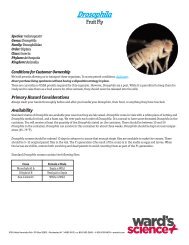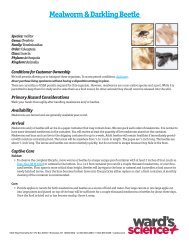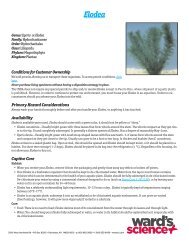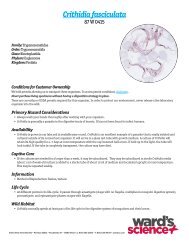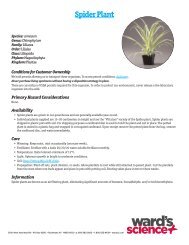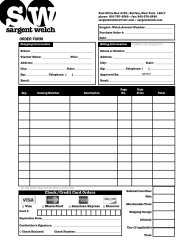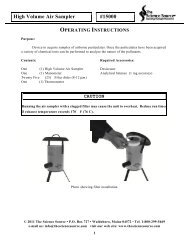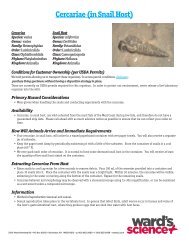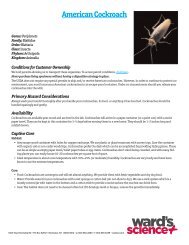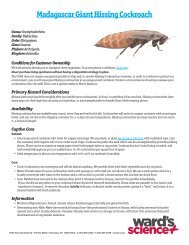Mosses, Liverworts, and Ferns - Sargent Welch
Mosses, Liverworts, and Ferns - Sargent Welch
Mosses, Liverworts, and Ferns - Sargent Welch
You also want an ePaper? Increase the reach of your titles
YUMPU automatically turns print PDFs into web optimized ePapers that Google loves.
<strong>Mosses</strong>, <strong>Liverworts</strong>, <strong>and</strong> <strong>Ferns</strong><br />
Sphagnum 86 W4400<br />
Species: magellanicum <strong>and</strong>/or<br />
papillosum<br />
Genus: Sphagnum<br />
Family: Sphagnaceae<br />
Order: Sphagnales<br />
Class: Bryopsida (Musci)<br />
Phylum: Bryophyta<br />
Kingdom: Plantae<br />
Leafy Liverwort 86 W4300<br />
Species: trilobata<br />
Genus: Bazzania<br />
Family: Lepidoziaceae<br />
Order: Jungermanniales<br />
Class: Hepaticae<br />
Phylum: Bryophyta<br />
Kingdom: Plantae<br />
Marchantia 86 W4200<br />
Species: polymorpha<br />
Genus: Marchantia<br />
Family: Marchantiaceae<br />
Order: Marchantiales<br />
Class: Hepaticae<br />
Phylum: Bryophyta<br />
Kingdom: Plantae<br />
Conocephalum 86 W4050<br />
Species: conicum<br />
Genus: Conocephalum<br />
Family: Conocephalaceae<br />
Order: Marchantiales<br />
Class: Hepaticae<br />
Phylum: Bryophyta<br />
Kingdom: Plantae<br />
Riccia 86 W7775<br />
Species: fluitans<br />
Genus: Riccia<br />
Family: Ricciaceae<br />
Order: Marchantiales<br />
Class: Hepaticae<br />
Phylum: Bryophyta<br />
Kingdom: Plantae<br />
Polytrichum 86 W4360<br />
Species: commune<br />
Genus: Polytrichum<br />
Family: Polytrichaceae<br />
Order: Polytrichales<br />
Class: Bryopsida (Musci)<br />
Phylum: Bryophyta<br />
Kingdom: Plantae<br />
Conditions for Customer Ownership<br />
We hold permits allowing us to transport these organisms. To access permit conditions, click here.<br />
Never purchase living specimens without having a disposition strategy in place.<br />
There are currently no USDA permits required for this organism. In order to protect our environment, never release a live laboratory<br />
organism into the wild.<br />
Primary Hazard Considerations<br />
None<br />
Woodl<strong>and</strong> Moss 86 W 4250<br />
(contains two species)<br />
Species: schreberi<br />
Genus: Pleurozium<br />
Family: Entodontaceae<br />
Order: Hypnobryales<br />
Class: Bryopsida (Musci)<br />
Phylum: Bryophyta<br />
Kingdom: Plantae<br />
Species: polysetum<br />
Genus: Dicranum<br />
Family: Dicranaceae<br />
Order: Dicranales<br />
Class: Bryopsida (Musci)<br />
Phylum: Bryophyta<br />
Kingdom: Plantae<br />
Woodl<strong>and</strong> <strong>Ferns</strong> 86 W 5500<br />
Genus <strong>and</strong> species vary with<br />
availability<br />
Family: Dryopteridaceae<br />
Order: Polypodiales<br />
Class: Polypodiopsida<br />
(Pteridopsida)<br />
Phylum: Pterophyta<br />
Kingdom: Plantae<br />
Boston Fern 86 W5550<br />
Species: exalta<br />
Genus: Nephrolepis<br />
Family: Nephrolepidaceae<br />
Order: Polypodiales<br />
Class: Polypodiopsida<br />
(Pteridopsida)<br />
Phylum: Pterophyta<br />
Kingdom: Plantae<br />
Equisetum 86 W5300<br />
Species: hiemale may vary<br />
depending on availability<br />
Genus: Equisetum<br />
Family: Equisetaceae<br />
Order: Equisetales<br />
Class: Equisetopsida<br />
Phylum: Pterophyta<br />
Kingdom: Plantae<br />
Selaginella<br />
Species: apoda<br />
Genus: Selaginella<br />
Family: Selaginellaceae<br />
Order: Selaginellales<br />
Class: Lycopodiopsida<br />
Phylum: Lycopodiophyta<br />
Kingdom: Plantae<br />
Availability<br />
• <strong>Mosses</strong>, liverworts, <strong>and</strong> ferns are generally available year round. Liverwort shortages may occur during the winter months, as<br />
they are wild-collected.<br />
• Fruiting bodies on mosses <strong>and</strong> liverworts are rare during the winter months as they are wild collected.<br />
• Equisetum shortages may occur during the winter months, as it is wild collected.<br />
• Individual mosses <strong>and</strong> liverworts are shipped in plastic bags in 7.5 x 10 cm portions. Upon receipt remove the plant from the bag.<br />
• <strong>Mosses</strong> <strong>and</strong> Bazzania trilobata can be stored in the freezer for 3–6 months prior to use.
• Marchantia <strong>and</strong> Conocephalum can be stored in the fridge for 1–2 weeks prior to use.<br />
• <strong>Ferns</strong>, Woodl<strong>and</strong> <strong>and</strong> Boston, are shipped in plastic pots with peat moss. For shipping purposes a cardboard disc is used to hold<br />
the plant <strong>and</strong> peat moss in place. The potted fern is sealed in a plastic bag <strong>and</strong> wrapped in corrugated cardboard. Upon receipt<br />
remove the potted plant from the bag, remove the cardboard disc <strong>and</strong> water immediately.<br />
• Equisetum is shipped wrapped in moist newsprint. The plant should be removed from the newsprint upon receipt <strong>and</strong> can be<br />
stored in a bucket of water for temporary storage at room temperature. Roots of Equisetum should be below the waterline.<br />
Care<br />
• <strong>Mosses</strong> <strong>and</strong> liverworts will survive for long periods of time if kept in moist chambers. Covering a large fingerbowl with a square<br />
piece of glass makes a very successful type. The bottom of the bowl is lined with paper toweling, thoroughly moistened. The specimens<br />
are placed in the bowl with a good portion of their substratum still attached <strong>and</strong> the container is covered. Relative humidity<br />
<strong>and</strong> moisture may be regulated by the degree to which the fingerbowl may be left uncovered by the square glass. <strong>Mosses</strong> that produce<br />
spore capsules in early spring may be brought into the laboratory <strong>and</strong> placed in such containers, where development will<br />
proceed normally.<br />
• For larger scale culture, a terrarium is satisfactory. Here the liverwort Conocephalum grows very well on a substratum of woodl<strong>and</strong><br />
soil <strong>and</strong> peat, with normal light. Marchantia may be grown on a substratum of s<strong>and</strong>y soil to which wood ashes or powdered charcoal<br />
is added. Since Marchantia requires rather full light, the use of a fluorescent light attachment is recommended.<br />
• Equisetum is easily grown in st<strong>and</strong>ard potting soil. It should be planted in a 22 centimeter or larger pot without a drainage hole. It<br />
is not affected by poor drainage <strong>and</strong> needs to be watered only every 2 weeks. Full sunlight is best <strong>and</strong> the plant may be kept outdoors<br />
all summer.<br />
• Some species of Selaginella are cultivated as ornamentals. Potted in s<strong>and</strong>y soil <strong>and</strong> fertilized periodically with bone meal, they do<br />
very well in a terrarium or indoor greenhouses.<br />
Life Cycle<br />
• <strong>Ferns</strong> lack flowers or seeds. The life cycle, like all other vascular plants, is referred to as alternation of generations. This is<br />
characterized by a diploid sporophytic <strong>and</strong> a haploid gametophytic phase. The ferns’ gametophyte is a free-living organism<br />
(gymnosperms <strong>and</strong> angiosperms are not).<br />
• In liverworts <strong>and</strong> mosses, germination of a haploid spore to produce a protonema (mass of thread-like filaments or a flattened<br />
thallus) occurs. A mature gametophore plant that produces the sex organs grows from the protonema, a short-lived stage of<br />
the plant.<br />
• The male organ, known as the antheridia, is protected by the perigonium.<br />
• The female organ, known as the archegonia, is protected by the perichaetum.<br />
• <strong>Liverworts</strong> <strong>and</strong> mosses are either monoicous or dioicous.<br />
• In monoicous mosses <strong>and</strong> liverworts, male <strong>and</strong> female sex organs are borne on different branches of the same plant.<br />
• In dioicous mosses <strong>and</strong> liverworts the organs are borne on different <strong>and</strong> separate gametophyte plants.<br />
• Aided by the presence of water, sperm swim from the antheridia to the archegonium. The sperm would not be able to complete<br />
the journey without the assistance of water.<br />
• After fertilization, the immature sporophyte develops a foot, a capsule, <strong>and</strong> a seta. The seta will force its way out of the archegonium.<br />
Capsules are forced out by the seta <strong>and</strong> the foot acts as an anchor. Elater cells <strong>and</strong> spore producing cells are produced in the<br />
capsule. The elater cells push open the wall of the capsule to spread themselves. The spore producing cells will undergo meiosis to<br />
form haploid spores. These spores are dispersed, commencing the life cycle once again.<br />
Wild Habitat<br />
• <strong>Ferns</strong> prefer shady, moist conditions of woodl<strong>and</strong>s but some have adapted to dry habitats.<br />
• <strong>Mosses</strong> <strong>and</strong> liverworts are usually found in a damp environment with low light. They are common in wooded areas <strong>and</strong> at the<br />
edges of streams.<br />
Disposition<br />
We do not recommend releasing any laboratory specimen into the wild, <strong>and</strong> especially not specimens that are not native to the<br />
environment. When finished with your plant please dispose of it by incineration in a well-ventilated area.<br />
© 2008 Ward’ s Science. All rights reserved. Rev. 9/08, 11/09, 3/13



